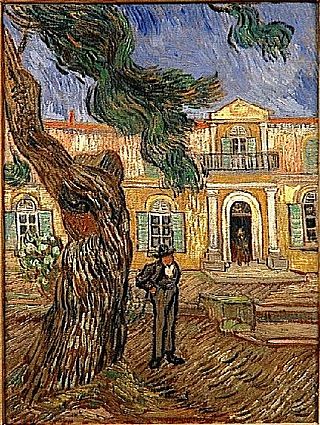A cottage is a small house.
Contents
Cottage may also refer to:
A cottage is a small house.
Cottage may also refer to:

Vincent Willem van Gogh was a Dutch Post-Impressionist painter who is among the most famous and influential figures in the history of Western art. In just over a decade he created approximately 2100 artworks, including around 860 oil paintings, most of them in the last two years of his life. They include landscapes, still lifes, portraits and self-portraits, and are characterised by bold, symbolic colours, and dramatic, impulsive and highly expressive brushwork that contributed to the foundations of modern art. Only one of his paintings was known by name to have been sold during his lifetime. Van Gogh became famous after his suicide at age 37, which followed years of poverty and mental illness.

Cottage cheese is a curdled milk product with a mild flavor and a creamy, heterogenous, soupy texture. It is made from skimmed milk by draining curds but retaining some of the whey and keeping the curds loose. An essential step in the manufacturing process distinguishing cottage cheese from other fresh cheeses is the addition of a "dressing" to the curd grains, usually cream, which is mainly responsible for the taste of the product. Cottage cheese is not aged.

The Potato Eaters is an oil painting by Dutch artist Vincent van Gogh painted in April 1885 in Nuenen, Netherlands.

The Yellow House, alternatively named The Street, is an 1888 oil painting by the 19th-century Dutch Post-Impressionist painter Vincent van Gogh.

Farms near Auvers or Thatched Cottages by a Hill is an oil painting by Vincent van Gogh that he painted in July 1890 when he lived in Auvers-sur-Oise, France. The painting is an example of the double-square canvases that he employed in his last landscapes.
Pop or POP may refer to:

Daubigny's Garden, painted three times by Vincent van Gogh, depicts the enclosed garden of Charles-François Daubigny, a painter whom Van Gogh admired throughout his life.

John Peter Russell was an Australian impressionist painter.

A weavers' cottage was a type of house used by weavers for cloth production in the putting-out system sometimes known as the domestic system.

Cottages is a subject of paintings created by Vincent van Gogh from 1883 and 1885. This is related to the Peasant Character Studies that Van Gogh worked on during the same time period.
Digger or diggers may refer to:

Vincent van Gogh enjoyed making Paintings of Children. He once said that it's the only thing that "excites me to the depths of my soul, and which makes me feel the infinite more than anything else." Painting children, in particular represented rebirth and the infinite. Over his career Van Gogh did not make many paintings of children, but those he completed were special to him. During the ten years of Van Gogh's career as a painter, from 1881 to 1890, his work changed and grew richer, particularly in how he used color and techniques symbolically or evocatively.

Saint-Paul Asylum, Saint-Rémy is a collection of paintings that Vincent van Gogh made when he was a self-admitted patient at the Saint-Paul asylum in Saint-Rémy-de-Provence, since renamed the Clinique Van Gogh, from May 1889 until May 1890. During much of his stay there he was confined to the grounds of the asylum, and he made paintings of the garden, the enclosed wheat field that he could see outside his room and a few portraits of individuals at the asylum. During his stay at Saint-Paul asylum, Van Gogh experienced periods of illness when he could not paint. When he was able to resume, painting provided solace and meaning for him. Nature seemed especially meaningful to him, trees, the landscape, even caterpillars as representative of the opportunity for transformation and budding flowers symbolizing the cycle of life. One of the more recognizable works of this period is The Irises. Works of the interior of the hospital convey the isolation and sadness that he felt. From the window of his cell he saw an enclosed wheat field, the subject of many paintings made from his room. He was able to make but a few portraits while at Saint-Paul.

Avenue of Poplars in Autumn is an oil painting created in 1884 by Vincent van Gogh.

Peasant Character Studies is a series of works that Vincent van Gogh made between 1881 and 1885.

The French town of Saintes-Maries-de-la-Mer is the subject of a series of paintings that Vincent van Gogh made in June 1888. When Van Gogh lived in Arles, he took a week-long trip to Saintes-Maries-de-la-Mer on the Mediterranean Sea, where he made several paintings of the seascape and town.

Thatched Cottages and Houses is an oil painting by Vincent van Gogh that he painted in May 1890 when he lived in Auvers-sur-Oise, France.

Houses at Auvers is an oil painting by Vincent van Gogh. It was created towards the end of May or beginning of June 1890, shortly after he had moved to Auvers-sur-Oise, a small town northwest of Paris, France.

Landscape at Auvers in the Rain is an oil painting on canvas by the Dutch Post-Impressionist painter Vincent van Gogh.
Lokshen mit kaese, (Yiddish: לאָקשן מיט קעז lokshn mit kez), also known as (Hebrew: איטריות וגבינה itriyot v’gvina), Jewish mac and cheese, lokshen with cheese, or Jewish egg noodles with cottage cheese, is an Ashkenazi Jewish dish popular in the Jewish diaspora particularly in the United States, consisting of lokshen, or Jewish egg noodles that are served with a cheese sauce typically made with cottage cheese and black pepper, and sometimes farmers cheese may be used in place of the cottage cheese, and sour cream, butter, caramelized onions, garlic, tomatoes, mint, currants, parmesan, and other ingredients may be added. Sometimes a sweet variety is made with cinnamon sugar. It has been compared to a deconstructed noodle kugel and is considered by many to be a Jewish comfort food.